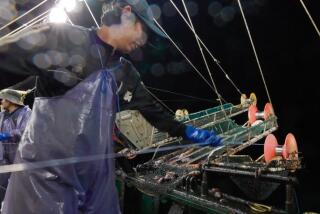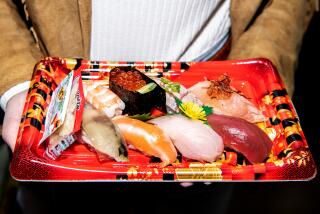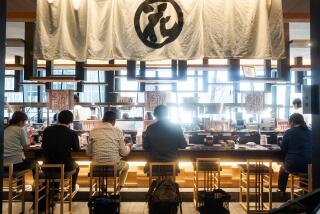Most U.S. Exporters Eat Up Japanese Trade Agreement : $2.5-Billion Beef Market Seen by Turn of Century
TOKYO â At first glance, what the Japanese call a âformed steakâ looks delicious.
The Japanese create this so-called steak from bits of offal--what Americans politely call âvariety meats.â For effect, a touch of fat is added at the edge.
This artistry makes it possible for the United States to sell about 60,000 tons of offal to Japan every year, but the U.S. Meat Export Assn. has not been happy with the arrangement. According to Philip Seng, the associationâs director for Asia, it has given American beef a bad name here.
âJapanese are always complaining that imported beef tastes bad,â Seng said, âbut weâre not allowed to sell our best products here.â
Until Monday, when U.S. and Japanese officials initialed what U.S. Trade Representative Clayton K. Yeutter called âa hallmark agreement,â offal constituted the only kind of beef that Americans could sell in Japan in unlimited quantities.
Although 85% of total U.S. beef exports is sold in Japan, everything but the offal falls under a quota here. Moreover, the Japanese governmentâs Livestock Industry Promotion Corp. specifies what cuts may be imported--lots of cheap chuck, brisket and ground meat, but very little sirloin, Seng said.
For example, he said, only 52 tons of U.S. sirloin, out of a U.S. beef import quota of 214,000 tons, was permitted during Japanese fiscal year 1987.
Bureaucratic Nightmare
The Japanese government has authorized 3,600 shops to sell imported beef, but many receive so little of it that they limit sales to three hours a day. Some, Seng said, offer only 33 pounds a day.
When American beef producers sell to Japan, he said, they must do so through the LIPC, the promotion agency. Then the beef staggers through a bureaucratic nightmare of a distribution system, from government-authorized wholesaler to government-authorized buyer, and only then to hotels, restaurants, supermarkets or neighborhood meat shops.
Now, all of that is about to change. As a result of Mondayâs agreement, beginning April 1, 1991, the U.S. beef industry can look forward to a future without quotas in Japan.
American beef exports to Japan, now valued at $600 million a year, could expand to between $2.5 billion to $3 billion by the turn of the century, Seng said.
Yeutter, looking ahead only to completion of the liberalization process, said U.S. beef exports would exceed $1 billion in six years.
To give Japanese cattle raisers time to adjust to the new competition, tariffs--now 25%--will be pegged at 70% in 1991, 60% in 1992 and 50% in 1993 and thereafter, pending future negotiations. But because the present system often drives beef prices to the consumer up as much as about three times the cost at the port of entry, Seng said, even such high tariffs are likely to bring retail prices down.
Ground beef now sells at $6.11 a pound and sirloin at up to $54 a pound at supermarkets in middle-class residential areas of Tokyo.
Agreement Praised
After April 1, 1991, the governmental livestock corporation, which has bought 80% of all imports--and played a key role in driving up prices--will no longer handle beef imports. Even before then, the 32 U.S. companies exporting beef to Japan will gradually be allowed to deal directly with customers here rather than with the corporation or with industry groups.
Like Yeutter, who is a former member of the board of the U.S. Meat Exporters Assn., Seng praised the agreement to open the market here, for the Reagan Administration appears to have achieved what had seemed only months ago to be unachievable.
Although Japan has eliminated all but 22 of the 76 quotas it maintained on farm imports in 1963, each step in the process invited major political turmoil. It is estimated that as many as 200 of the 444 members of the ruling Liberal Democratic Party in the two houses of Parliament look for support to farmers and farm organizations. And opposition parties embrace farm protectionism to an even greater degree than the ruling party.
With 347,000 Japanese households engaged in raising cattle, and 237,000 others growing citrus fruit, the issue of beef and orange import quotas has been especially sensitive. It has also been regarded as the last gate outside the sacred temple of rice, the heavily subsidized staple that keeps agriculture alive in Japan. Rice imports will continue to be banned.
Although Prime Minister Yasuhiro Nakasone removed most governmental barriers against imports of manufactured products during his five years in office, he refused even to discuss lifting quotas on beef and citrus. That was four years ago, in the last U.S.-Japan agreement on trade in the two commodities.
In that 1984 agreement, the United States wound up with only a minuscule 6,900-tons-a-year annual expansion in the beef quota. But this time Prime Minister Noboru Takeshitaâs government approved annual increases of 60,000 tons a year, until the quotas are lifted after three years.
Imports Increase
Even more significant, instead of the old pattern of liberalization-without-suffering, the increase threatened to inflict real injury on Japanese producers. In 1984, Japan estimated that beef demand would increase by 9,000 tons a year, and expanded import quotas for the United States and Australia by exactly that amount. Japanese cattlemen were guaranteed that imports would not eat into their established market and that consequently they would suffer no injury.
No such assurance was offered this time. Takeshitaâs government opened the door to imports exceeding the expected increase in demand.
By 1995, an increase of 60,000 tons a year for U.S. exporters will add up to a total increase of 480,000 tons over the 1987 figure. The Agriculture Ministry estimated in February that the increase in imports should be held to 320,000 tons in 1995 to insure that foreign beef does not squeeze out Japanese farmers.
Yeutter and Seng pointed out that Japan has a tariff and distribution system that doubles and triples the price of imported feed grains. A lifting of restrictions on imports of inexpensive feed would help the farmers, they said.
Seng sees the new agreement as beneficial to the Japanese farmer in the long term. Liberalization of the beef market, he said, could expand consumption far beyond what the Agriculture Ministry expects.
More to Read
Eat your way across L.A.
Get our weekly Tasting Notes newsletter for reviews, news and more.
You may occasionally receive promotional content from the Los Angeles Times.










